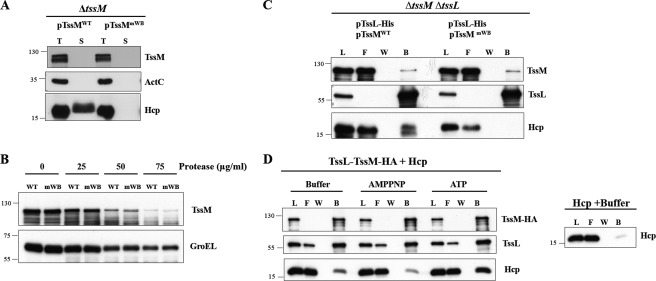FIGURE 6.
Effect of TssM ATP hydrolysis activity in Hcp secretion and the formation of TssM-TssL-Hcp complex and its conformational change. A, total proteins (T) and secreted proteins (S) isolated from the A. tumefaciens ΔtssM mutant harboring plasmids expressing either WT TssM (pTssMWT) or Walker B amino acid substitution mutant TssMD188A/G191A (pTssMmWB) were analyzed by immunoblotting using antisera against Hcp, C-TssM, and ActC, respectively. ActC serves as a nonsecreted protein control. The positions of the molecular mass markers (in kDa) are indicated. B, the A. tumefaciens ΔtssMΔtssL strain harboring plasmids expressing TssL-His (pTssL-His) with either WT TssM (pTssM) or the Walker B mutant (pTssMD188A/G191A) was subjected to the spheroplast protease susceptibility assay at different protease concentrations as indicated. The degree of susceptibility or resistance to protease in ΔtssMΔtssL (pTssL-His + pTssM) (WT) and ΔtssMΔtssL (pTssL-His + pTssMD188A/G191A) (mWB) was analyzed by immunoblotting using antisera against C-TssM and GroEL, respectively. C, DDM-soluble membrane proteins isolated from ΔtssMΔtssL (pTssL-His + pTssMWT) and ΔtssMΔtssL (pTssL-His + pTssMmWB) were purified by Ni2+-NTA affinity chromatography. The load (L), flow-through (F), and washed (W) and bound (B) fractions were analyzed by immunoblotting with antisera against N-TssL and Hcp, respectively. The positions of molecular mass markers (in kDa) are indicated. D, in vitro assay for TssM-TssL-Hcp complex formation in the presence of ATP or non-hydrolyzable ATP. TssL-TssM-HA protein complex purified from E. coli membrane was treated with hexokinase to remove cellular ATP and then incubated with purified Hcp-His in the presence or absence of ATP or non-hydrolyzable ATP (AMPPNP) followed by co-immunoprecipitation using anti-HA-agarose beads. The load, flow-through and washed and bound fractions were analyzed by immunoblotting with antisera against N-TssL, Hcp, and C-TssM, respectively. The right panel shows the background signal of nonspecific binding of Hcp-His to the beads in absence of TssL-TssM-HA complex.

